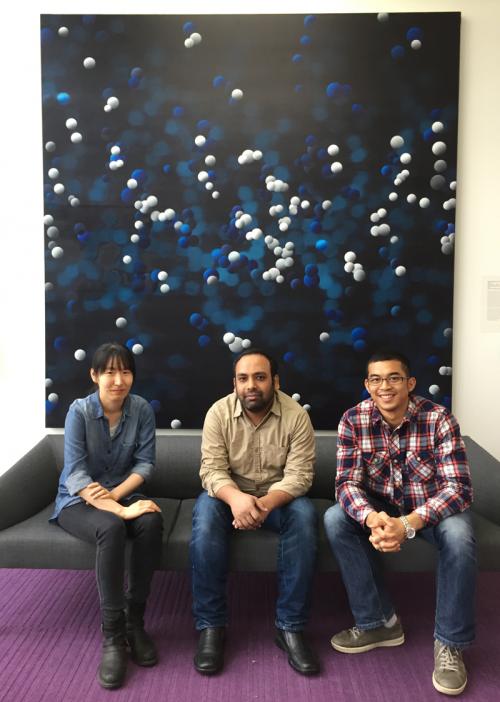
Kulathu Lab discovers a new family of enzymes that regulates the ubiquitin system
In ground-breaking new work published in Molecular Cell, Yogesh Kulathu and colleagues report the discovery of a completely new family of Deubiquitinating enzymes (DUBs).
Ubiquitin signals impact a wide range of eukaryotic biology. It is therefore very important that these signals are tightly regulated. This layer of regulation is provided by dedicated proteases called deubiquitinating enzymes (DUBs), of which there are ~100 encoded in the human genome that can be classified into five families.
In a team effort, Syed Arif Abdul Rehman, Yosua Adi Kristariyanto and Soo-Youn Choi in the Kulathu lab identified and characterized deubiquitinating activity in a completely unstudied protein (FAM63A). When analysing the sequence of FAM63A, Dr. Kulathu noticed that it had conserved residues in a signature typically found in cysteine proteases. Since FAM63A also has a ubiquitin binding motif that selectively binds to K48-linked ubiquitin chains, they wondered if FAM63A could be a DUB.
'To our surprise, we found that FAM63A was indeed a DUB with high selectivity at cleaving K48-linked polyubiquitin chains', Dr. Kulathu said. Through further sequence analysis, they narrowed down the catalytic activity to be encoded within a previously unannotated domain of unknown function (DUF544). Syed Arif then determined the crystal structure of the catalytic domain which revealed a distinct fold with no homology to any of the known DUBs. This makes FAM63A a prototype of a completely new family of DUBs that the team named MINDY (MIU containing Novel DUB family).
With the help of Prof. Kay Hofmann at the University of Cologne, they identified distantly related FAM188 members to also form part of the MINDY family of DUBs. MINDY DUBs are found in all eukaryotes and intriguingly they are all highly selective at cleaving K48-linked chains, the signal that targets proteins for proteasomal degradation. When proteins aren't degraded properly, misfolded and aggregated proteins can accumulate. This is a common contributing factor to age-related diseases such as Alzheimer's disease and Frontotemporal dementia (FTD).
Dario Alessi, Director of the MRC PPU noted 'I congratulate Yogesh and his team for this stunning piece of research. This discovery was totally unexpected as I thought that all the DUBs had been identified and catalogued. It emphasises that we don't know everything and there is still lots of important biology out there just waiting to be uncovered. Above all, this work illustrates the importance of curiosity driven research that one is able to undertake in the core-funded environment of an MRC Unit. It is going to be so exciting to see what roles the MINDY DUBs play in regulating biology in future research.'
This work was funded by the Medical Research Council. The Kulathu lab has recently obtained further funding from Tenovus Scotland, and is looking to hire a postdoctoral researcher hire a postdoctoral researcher to unravel roles for this new family of enzymes in maintaining protein homeostasis. Informal enquiries may be addressed to [email=y.kulathu@dundee.ac.uk]Yogesh[/email].
Ubiquitin signals impact a wide range of eukaryotic biology. It is therefore very important that these signals are tightly regulated. This layer of regulation is provided by dedicated proteases called deubiquitinating enzymes (DUBs), of which there are ~100 encoded in the human genome that can be classified into five families.
In a team effort, Syed Arif Abdul Rehman, Yosua Adi Kristariyanto and Soo-Youn Choi in the Kulathu lab identified and characterized deubiquitinating activity in a completely unstudied protein (FAM63A). When analysing the sequence of FAM63A, Dr. Kulathu noticed that it had conserved residues in a signature typically found in cysteine proteases. Since FAM63A also has a ubiquitin binding motif that selectively binds to K48-linked ubiquitin chains, they wondered if FAM63A could be a DUB.
'To our surprise, we found that FAM63A was indeed a DUB with high selectivity at cleaving K48-linked polyubiquitin chains', Dr. Kulathu said. Through further sequence analysis, they narrowed down the catalytic activity to be encoded within a previously unannotated domain of unknown function (DUF544). Syed Arif then determined the crystal structure of the catalytic domain which revealed a distinct fold with no homology to any of the known DUBs. This makes FAM63A a prototype of a completely new family of DUBs that the team named MINDY (MIU containing Novel DUB family).
With the help of Prof. Kay Hofmann at the University of Cologne, they identified distantly related FAM188 members to also form part of the MINDY family of DUBs. MINDY DUBs are found in all eukaryotes and intriguingly they are all highly selective at cleaving K48-linked chains, the signal that targets proteins for proteasomal degradation. When proteins aren't degraded properly, misfolded and aggregated proteins can accumulate. This is a common contributing factor to age-related diseases such as Alzheimer's disease and Frontotemporal dementia (FTD).
Dario Alessi, Director of the MRC PPU noted 'I congratulate Yogesh and his team for this stunning piece of research. This discovery was totally unexpected as I thought that all the DUBs had been identified and catalogued. It emphasises that we don't know everything and there is still lots of important biology out there just waiting to be uncovered. Above all, this work illustrates the importance of curiosity driven research that one is able to undertake in the core-funded environment of an MRC Unit. It is going to be so exciting to see what roles the MINDY DUBs play in regulating biology in future research.'
This work was funded by the Medical Research Council. The Kulathu lab has recently obtained further funding from Tenovus Scotland, and is looking to hire a postdoctoral researcher hire a postdoctoral researcher to unravel roles for this new family of enzymes in maintaining protein homeostasis. Informal enquiries may be addressed to [email=y.kulathu@dundee.ac.uk]Yogesh[/email].

